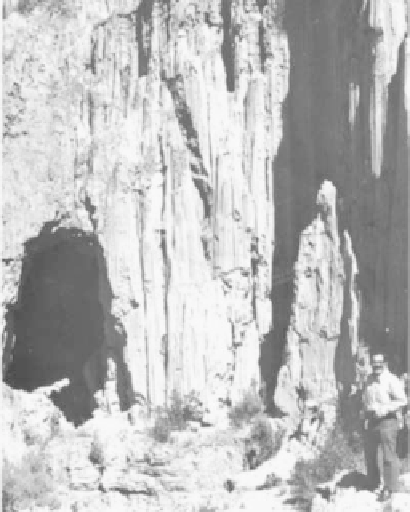Environmental Engineering Reference
In-Depth Information
FIGURE 10.36
Tunnel about 7 m high formed from piping in
colluvial-lacustrine clayey silts, near La Paz, Bolivia.
The vertical slopes are about 15 m in height.
forming in the remains of the enormous ancient mudflow shown in
Figure 9.55.
The mas-
sive movement of the flow destroyed the original structure of the formation and it came to
rest in a loose, remolded condition in which fissures subsequently developed. Rainwater
entering surface cracks passes along the relict fissures and erodes their sides.
Dispersive Clays
Occurrence
Erosion tunnels from piping in earth dams constructed with certain clay soils are a rela-
tively common occurrence that can seriously affect the stability of the embankment
(Sherard et al., 1972). It was originally believed that the clay soils susceptible to dispersion
erosion were limited to dry climates, but in recent years these soils and their related prob-
lems have been found to exist in humid climates. Sherard et al. (1972) cite examples in the
United States from Oklahoma and Mississippi and from western Venezuela.
The Phenomenon
Dispersive clays erode in the presence of water by dispersion or deflocculation. In certain
clay soils in which the electrochemical bond is weak, contact with water causes individual
particles to detach or disperse. Flowing fresh water readily transports the dispersed parti-
cles in the form of piping erosion, in time creating voids or tunnels in the clay mass as
illustrated in
Figure 10.37
and
Figure 10.38.
Any fissure or crack from desiccation or set-
tlement can provide the initial flow channel. In expansive clays, the cracks will close by
swelling and dispersion will not occur. The failure of many small dams and dikes has been
attributed to dispersive clays.
Soil Susceptibility
The main property governing susceptibility to dispersion appears to be the quantity of
dissolved sodium cations in the pore water relative to the quantities of other main cations



